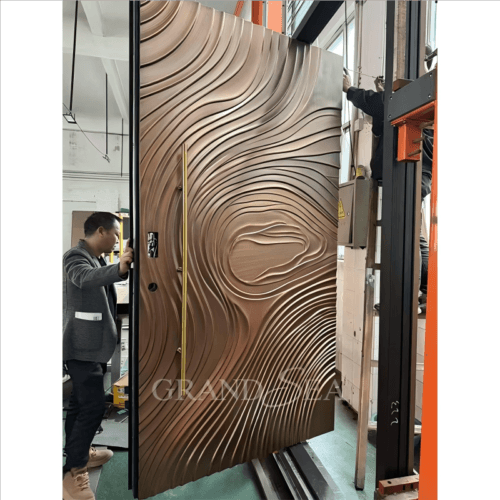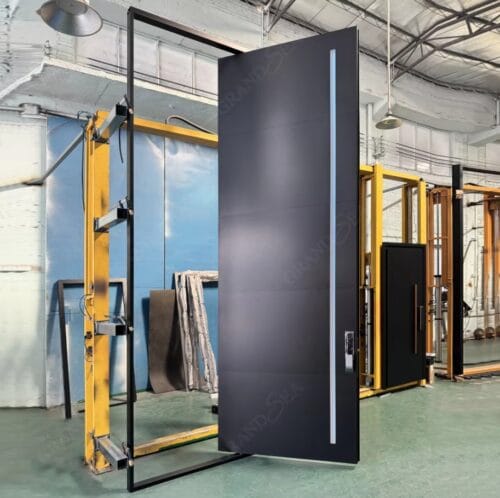Choosing the right front door for your home is more significant than you might think. As the first element you and your guests see, it sets the tone for the entire property. Are you opting for the traditional appeal of a hinged door, or maybe the modern, sleek appearance of a pivoting door?
Pivot doors have been gaining popularity for their unique and grand designs. But how do they compare to traditional hinged doors? In this article, we’ll delve into their differences, personalization, everyday use methods, and more to help you decide on the best front door to buy for your lovely home.
What is a Pivot Door?
First things first, let’s get our heads around what these doors actually are.
A pivot door is essentially a swinging door that, instead of being attached to a frame with hinges on the side, rotates on a vertical axis or spindle. Think of it as a panel that pivots, and the clever bit is that it can be custom-designed to suit just about any space you can imagine. It is commonly seen in pivot front doors,pivot shower doors and interior pivot doors.

Now, when you look at a pivot door, you won’t see bulky hardware. That’s because the mechanism, which includes the door panel, pivot system, top pivot, floor plate, ceiling plate, and roller catches, is cleverly concealed to create a minimalist look. The magic happens with a pivot hinge system and a top pivot that remain hidden once the door is in place. This system works by the top pivot supporting the door and helping it rotate, while the bottom pivot takes the weight and guides the rotation along with the top.
Something rather interesting happens when a pivot door opens – it creates active and inactive spaces. The active space is where you walk through, and the inactive space is more of a visual bit that you notice when the door’s open.
Believe it or not, pivot doors are not a new invention! Their history can be traced back to ancient Egypt, Rome, Greece and Iran. They appeared in prehistoric stone buildings and were used in grand places such as castles and passageways. These early doors were often large and heavy, perfect for large entrances. Modern architects also love pivot doors because of their simple design and practicality – they can really be very grand.

What about the hinged door?
Ah, the hinged door – the one most of us picture when we think of a door. It’s the most common design worldwide. Simple but effective, it’s fixed to a door frame using two to three hinges, allowing it to swing open and closed with ease.
Hinged doors are easy to use and they simply work well. In fact, they are generally simple to install, and their operation is intuitive. They can also be set up to open either inward or outward.

Looks Matter: Your own custom pivot door
Now, let’s talk about appearances, shall we? This is where the difference between pivot and regular swing doors really shines.
Seeing the Difference
One of the first things you’ll notice is that pivot doors are often much taller and wider than your standard hinged door. If you want a grand entrance that makes a statement, a pivot door could be the ideal choice for you. They have a sleek, unique, and striking appearance, often becoming a real focal point for your home. The way a pivot door moves is rather elegant too – it rotates smoothly, which is quite captivating to watch, whether it’s open or closed.
Hinged doors, on the other hand, offer a more conventional look. That’s not to say they can’t be stylish though, as they can still be custom-made to match your design needs.
Making It Personal: Customisation
The great news is that whether you fancy a pivot or a hinged door, you’ve got plenty of scope to make it your own. At Grandsea, we specialize in offering customized pivot and hinged doors to bring your design dreams to life. From the initial ideas right through to the final fitting, every little detail, from the glass and hinge colour to the all-important pivot point, is carefully chosen to match your vision. For pivot doors, you can even choose the location of the pivot point to achieve a specific look.

So, no matter if you’re after a door made of iron, glass, wood, or metal, with just the right finish and those perfect handles (whether they’re on hinges or a pivot system), you can really create something special.
How It Changes the Inside and Out
Think about how your new door will fit with the rest of your home. A pivot door can truly “revolutionize the face of your home” with its modern and unique design. However, bear in mind that because they tend to be larger and have that swinging motion, pivot doors do need a bit more space in your entryway to avoid looking cramped.
Hinged doors, being more traditional in size and operation, can often fit into the existing space you already have. While they offer a more familiar feel, they can still be designed to perfectly complement your home’s style.
What are the benefits of having a pivot door?
Let’s get down to the nitty-gritty of how pivot doors function in your daily life.
Getting Them Fitted
Pivot doors are slightly more complicated to install than hinged doors or double front doors and usually require professional installation knowledge. They require more space and the modern pivot hinge system installed at the top and bottom requires the professionalism of the installer. But don’t worry too much, if you choose Grandsea’s pivot doors, we will accompany you from design to installation.
How They Open and Close
Pivot doors operate by rotating around a pivot at the top and bottom, usually on one side of the door. Many people find this rotating motion smooth and effortless. Because the weight is evenly distributed on the pivot mechanism, there is no excessive tension, ensuring smooth operation. We even offer modern pivot hinges with electronic power assistance. This allows for a hands-free door opening with sensor-activated operation.
Weather Sealing and Sound Insulation
High-quality hinged doors create a tight seal against the frame, which prevents air leakage and provides excellent sound and thermal insulation.
Pivot doors don’t typically provide the same level of natural seal. While they can be customised with extra soundproofing, it’s something to consider. However, pivot doors do usually require an ADA threshold, which does provide a tight seal from your inside floor to the outside. Ideally, pivot doors are best suited for locations that are semi or fully protected, perhaps with a good overhang, to minimise exposure to harsh weather and potential drafts. If air testing your new build is important, a hinged door might give you better results due to the potential for air leakage with a pivot door.
The Cost of Pivot Doors
Now, let’s talk about what it’ll cost you and how much looking after they need.
The Initial Outlay
Generally speaking, pivot doors tend to have higher upfront costs than swing doors. This is usually because the mechanism and installation process are more complicated. Depending on the materials, size, and design, a pivot door can cost anywhere from $1,000 to $16,000 or more. Don’t forget that the more complicated installation process for a pivot door also means higher labor costs. And the accessories for the pivot system itself are also initial costs that can’t be ignored.

Maintenance and Durability
Pivot doors have fewer moving parts, which means there is a lower likelihood of mechanical issues like squeaking or misalignment over time.

How should I choose pivot entry doors for my home? Our Expert Tips for You
So, what should you keep in mind when buying your great pivot doors:
- Consider the space you have in your foyer and how the door will look from the outside.
- If air testing and top-notch energy efficiency are high on your list, a hinged door might be the safer bet.
- If you do go for a pivot door, try to install it in a location that’s at least partially sheltered, like under a porch or with a good overhang.
- It’s always a good idea to chat with designers and think about which way the wind typically blows against your door, especially with a pivot door.
- For pivot doors, make sure you opt for high-quality pivot hardware to avoid any headaches down the line.

If you are undecided about the design of pivot doors, why not contact our experts and browse our pivot door examples in real homes. You can learn more about how Grandsea has become a new high-quality door and window brand and how it produces different types of pivot doors to create a stunning entrance.
Pivot VS hinged doors: the Pros and Cons
To make things nice and clear, here’s a quick rundown of the main advantages and disadvantages:
Pivot Doors:
- Pros: They offer a sleek, unique, and often more grand look. They can also be very durable due to having fewer parts that can wear out. Plus, they can be made in really large sizes.
- Cons: They are generally more difficult to install and take up more space due to their swing. They tend to cost more. You might experience more noise and air leakage compared to a well-sealed hinged door. There’s also a small chance of wood warping with wooden pivot doors, although this isn’t usually an issue with our iron doors.

Hinged Doors:
- Pros: They are easy to install and use. Almost everyone is familiar with them. They typically offer better weather and noise sealing. Common issues like a squeaky hinge are usually easy to fix yourself.
- Cons: The hinges can sometimes warp or break over time and need replacing. They require regular oiling to stay smooth. Some might find their look a bit more conventional.
How should I choose entry doors for my home?
When deciding between a pivot or hinged door for your entryway, the choice ultimately comes down to personal preference, practical considerations, your home’s layout, and budget.
Consider your priorities and the most important things to you. Whatever you choose be sure to keep in mind that Grandsea Building can assist you to make a gorgeous and efficient front door to your house. Contact us to discuss the details of your plan.


